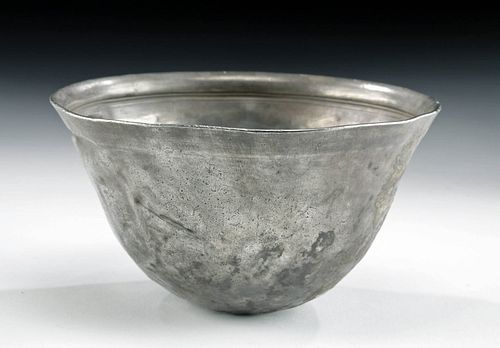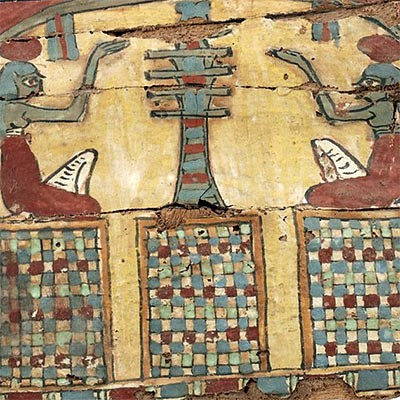Greek Hellenistic Silver Mastoid Bowl
Lot 26
About Seller
Artemis Fine Arts
686 S Taylor Ave, Ste 106
Louisville, CO 80027
United States
Selling antiquities, ancient and ethnographic art online since 1993, Artemis Gallery specializes in Classical Antiquities (Egyptian, Greek, Roman, Near Eastern), Asian, Pre-Columbian, African / Tribal / Oceanographic art. Our extensive inventory includes pottery, stone, metal, wood, glass and textil...Read more
Categories
Estimate:
$1,500 - $3,000
Absentee vs Live bid
Two ways to bid:
- Leave a max absentee bid and the platform will bid on your behalf up to your maximum bid during the live auction.
- Bid live during the auction and your bids will be submitted real-time to the auctioneer.
Bid Increments
| Price | Bid Increment |
|---|---|
| $0 | $25 |
| $300 | $50 |
| $1,000 | $100 |
| $2,000 | $250 |
| $5,000 | $500 |
| $10,000 | $1,000 |
| $20,000 | $2,500 |
| $50,000 | $5,000 |
| $100,000 | $10,000 |
| $200,000 | $20,000 |
About Auction
By Artemis Fine Arts
Jul 30, 2020
Set Reminder
2020-07-30 10:00:00
2020-07-30 10:00:00
America/New_York
Bidsquare
Bidsquare : Ancient / Ethnographic From Around the World
https://www.bidsquare.com/auctions/artemis-gallery/ancient-ethnographic-from-around-the-world-5382
Ancient art from Egypt, Greece, Italy and the Near East, as well as Asian, Pre-Columbian, Native American, African / Tribal / Oceanic, Spanish Colonial, Russian Icons, Fine art, much more! All categories, all price ranges... all legally acquired and guaranteed to be as described or your money back. Artemis Fine Arts info@artemisgallery.com
Ancient art from Egypt, Greece, Italy and the Near East, as well as Asian, Pre-Columbian, Native American, African / Tribal / Oceanic, Spanish Colonial, Russian Icons, Fine art, much more! All categories, all price ranges... all legally acquired and guaranteed to be as described or your money back. Artemis Fine Arts info@artemisgallery.com
- Lot Description
Greece, Hellenistic Period, ca. late 4th to 1st century BCE. A stunning bowl of a substantial size in the form of a mastos or mastoid, a drinking vessel shaped like a breast, shaped from near-pure (97%) silver. The vessel is conical in form with a rounded base, gradually-expanding walls with a thin rim, a deep basin, and an incised band around the interior lip. During the Hellenistic period, wealthy Greeks used silver as a marker of wealth more commonly than they had in the past. During the 5th century, a new silver source was discovered in the Laurium Hills in Attica, which was mined extensively soon thereafter. The profits from the mines enriched several Athenian families and created a greater pool of silver with which artisans could produce fine goods like this cup. Size: 5.75" W x 3.25" H (14.6 cm x 8.3 cm); silver is 97%; 256 grams
The mastos form seems to be deliberately breast-shaped, based on archaeological findings suggesting ritual functions for these cups. Mastoid cups and ceramic votive representations of breasts have been found at sanctuaries to Diana and Hercules - two figures in classical religion associated with birth, nursing, and rearing children. Fascinatingly, some of these even have dedications made by wet nurses. Some scholars theorize that the drinking of breast milk from a vessel like this one by an elderly or deathly ill adult symbolized rebirth in the afterlife.
Provenance: private Colorado, USA collection, purchased in 2016 from C.J. Martin, London, UK; ex-London, UK collection, acquired in the 1980s
All items legal to buy/sell under U.S. Statute covering cultural patrimony Code 2600, CHAPTER 14, and are guaranteed to be as described or your money back.
A Certificate of Authenticity will accompany all winning bids.
We ship worldwide and handle all shipping in-house for your convenience.
#150976The rim is slightly bent in several places, with some light indents on the body.Condition
- Shipping Info
-
All shipping is handled in-house for your convenience. Your invoice from Artemis Gallery will include shipping calculation instructions. If in doubt, please inquire BEFORE bidding for estimated shipping costs for individual items.
-
- Buyer's Premium



 EUR
EUR CAD
CAD AUD
AUD GBP
GBP MXN
MXN HKD
HKD CNY
CNY MYR
MYR SEK
SEK SGD
SGD CHF
CHF THB
THB
















